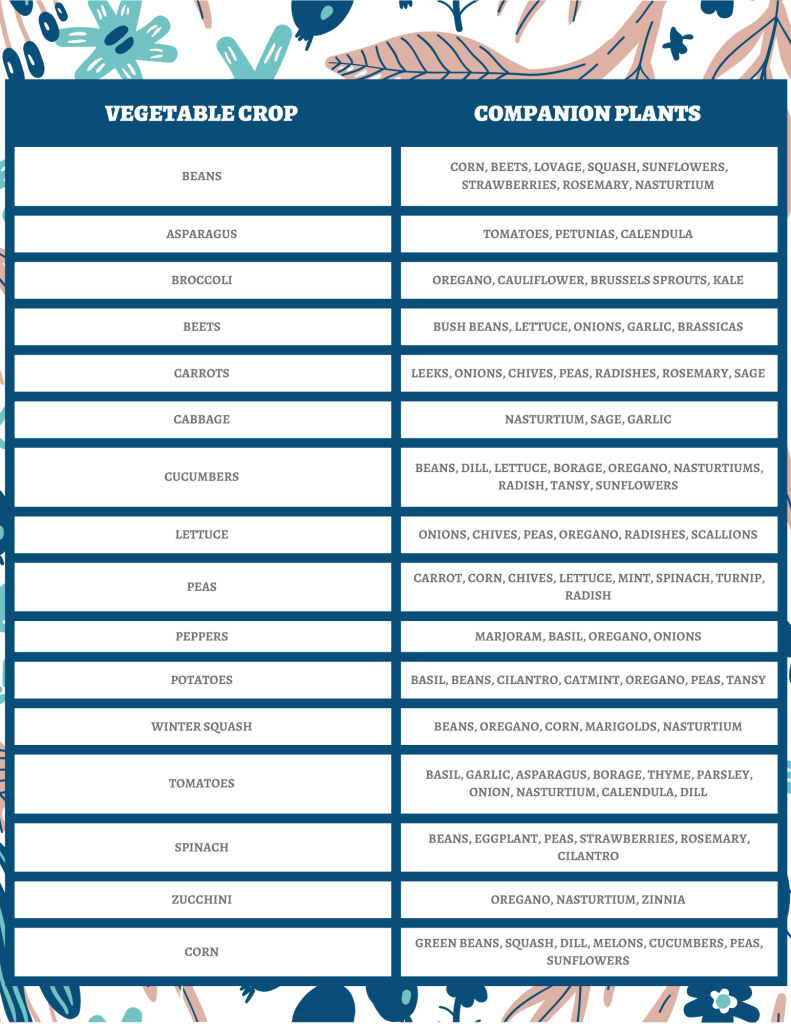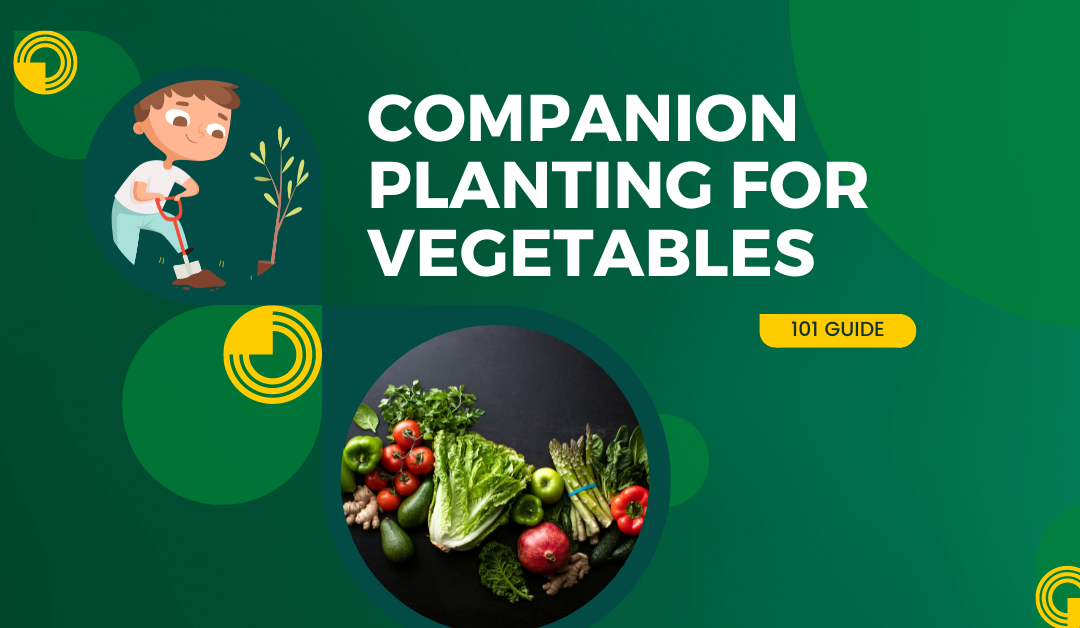Companion planting for vegetables is a strategy used by gardeners to naturally deter insect pests, attract beneficial insects and improve production. The goal is to place plant “friends” close together to benefit each other.
A simple example is planting nectar-rich flowers near your vegetables to attract pollinators. You can also plant two vegetable friends next to each other to repel or confuse pests.
One great example of companion planting at work is the Three Sisters trio – climbing beans, maize and winter squash. These crops were commonly planted together by Native American communities because they play amazingly well together.
- The corn stalks are a natural trellis for climbing beans.
- The squash shades the ground to improve moisture retention. Their prickly leaves deter weeds and pests.
- The quick-growing beans served as nitrogen fixers to make more nutrients available to plants.
The Three Sisters trio is a prime example of how companion planting works. You may have also heard that you should plant tomatoes with basil. There’s a good reason for that. Basil is believed to repel pests, like hornworms, and even improve plant yields.
Placing plant friends together can help keep your vegetable garden healthy and thriving naturally. But when choosing companion plants, it’s important to remember that plants also have “enemies.” Just as some plants get along really well together, some plants can also work against each other.
The Benefits of Companion Planting
Planting plant friends together can benefit your garden in many ways. Here’s what companion planting can do for your vegetable garden:
Protect Against Insect Pests
Some plants naturally deter certain pests, which can benefit plants susceptible to those pests. For example, borage is a natural hornworm deterrent. Planting it near tomatoes can keep these destructive critters away.
Attract Beneficial Insects
Other plants can attract beneficial insects, like aphid-eating ladybugs or pollinating bees. Planting these attractors can introduce natural predators of pesky pests and ensure your plants are pollinated.
Add Soil Nutrients and Improve Plant Health
Many plants have beneficial relationships when it comes to soil nutrients. For example, some plants fix certain nutrients, like nitrogen, into the soil to make them available to nearby plants. Other plants can change soil biochemistry, creating more favorable conditions for plant neighbors.
- Beans and other legumes make nitrogen more readily available in the soil.
- Plants with long taproots can bring nutrients up to the surface to enrich the topsoil.
Add Shade and Suppress Weeds
Placing certain plants near each other can help suppress weeds and provide much-needed shade for some crops.
For example, tomatoes can provide some shade for lettuce to protect it from the hot sun and prevent bolting or wilting.
Sprawling plants like potatoes can suppress weeds by minimizing open space.
Serve as Natural Supports
Tall plants can also serve as natural supports for sprawling or climbing plants, like pole beans, peas and cucumbers.
As you can see, when you plan your garden layout with companion plants in mind, you can work with nature rather than against it. It’s no wonder companion planting is so important for an organic garden.
So, you know why companion planting is so beneficial and how it works. But which plants are enemies and friends? Let’s look at common vegetable garden plants and their best companions.
Companion Planting Chart For Vegetables
Here’s a handy companion planting chart for vegetables:
|
Vegetable Crop |
Companion Plants |
|
Beans |
Corn, beets, lovage, squash, sunflowers, strawberries, rosemary, nasturtium |
|
Asparagus |
Tomatoes, petunias, calendula |
|
Broccoli |
Oregano, Cauliflower, Brussels sprouts, kale |
|
Beets |
Bush beans, lettuce, onions, garlic, brassicas |
|
Carrots |
Leeks, onions, chives, peas, radishes, rosemary, sage |
|
Cabbage |
Nasturtium, sage, garlic |
|
Cucumbers |
Beans, dill, lettuce, borage, oregano, nasturtiums, radish, tansy, sunflowers |
|
Lettuce |
Onions, chives, peas, oregano, radishes, scallions |
|
Peas |
Carrot, corn, chives, lettuce, mint, spinach, turnip, radish |
|
Peppers |
Marjoram, basil, oregano, onions |
|
Potatoes |
Basil, beans, cilantro, catmint, oregano, peas, tansy |
|
Winter squash |
Beans, oregano, corn, marigolds, nasturtium |
|
Tomatoes |
Basil, garlic, asparagus, borage, thyme, parsley, onion, nasturtium, calendula, dill |
|
Spinach |
Beans, eggplant, peas, strawberries, rosemary, cilantro |
|
Zucchini |
Oregano, nasturtium, zinnia |
|
Corn |
Green beans, squash, dill, melons, cucumbers, peas, sunflowers |
Note: We covered the most popular garden vegetables. There are certainly more beneficial plant combinations out there, but there are just too many to list in one blog!
We’ve added a helpful printable of this chart to the end of this article! Check it out.
Flower Companion Planting for Vegetables
Companion plants don’t necessarily have to be other vegetables. In fact, some of the best companion plants are flowers and herbs. These include:
Marigold
You’ve probably heard that you should plant marigolds in your vegetable garden, and there’s a good reason for that.
Marigolds do a few things for your plants:
- They attract pollinators, like bees and butterflies.
- They attract other beneficial insects, like aphid-loving ladybugs.
- They contain limonene, which naturally deters whiteflies.
- Their roots secrete substances that kill nematodes.
Plus, marigolds are so easy to grow and add beautiful color to your garden.
There are few plants that marigold can’t complement. Some of its top companions include:
- Tomatoes
- Cucumbers
- Potatoes
- Garlic
- Onions
- Eggplant
- Squash
- Cabbage
- Kale
- Carrots
Nasturtiums
These beautiful climbing flowers attract caterpillars, which can help keep them away from your vegetable plants. They’re also great for luring blackflies.
As a bonus, nasturtiums are edible, so they can serve as an extra “herb” for your garden.
Basil
Basil is a wonderful companion plant. They can repel pests like thrips, but they also disorient the moths that lay tomato hornworms. Planting tomatoes and basil together can be highly effective at reducing armyworms. They also help attract pollinators that increase tomato production and flavor.
Sage
Sage is a great addition to any garden. It’s a perennial, so it will come back every year. And along with its culinary uses, sage can also protect your vegetable crops.
Sage helps repel carrot fly and cabbage moths.
Parsley
Like basil, parsley helps attract beneficial insects that pollinate or dine on pests. Plant them near tomatoes to help improve production.
Tansy
Tansy is the ideal flower to plant in your vegetable garden because it attracts pest-eating bugs, like ladybugs, and predatory wasps. But they can also repel some nasty pets, like cutworms. The great thing about tansy is that it’s a perennial, so it will return every year to help protect your garden.
Mint
Along with being a great herb for your kitchen, mint is a great plant for your garden. It naturally repels aphids, flea beetles, ants and other pests. Just make sure that you keep a watchful eye on this herb, as it can take over your whole garden.
Dill
Dill is another exceptional herb for the garden. It attracts ladybugs, which eat aphids, and spider mites.
Final Thoughts
Companion planting can help keep your garden healthy and make your life a little easier. Choose your plants wisely and plan out your layout to incorporate friendly plant pairings when planting your next garden.
Printable Companion Planting Chart

Rene is a creative, little gnome. When she's not diving deep into research on health and wellness, she's spending here time out in nature, growing her homestead, photographing wildlife, doing yoga or enjoying a zen (depending on the day) moment with her fur babies. And on top of all of that, she's a professional writer by day, helping businesses around the world grow.

